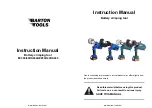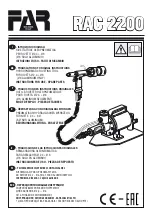
2
CHANGING CLUTCH SPRINGS
To prevent parts from falling out, keep the tool in a vertical position while changing springs.
1.
Remove #07096 screw from side of clutch case with a 1/8" (3.2 mm) hex wrench.
2.
Depending on the type of tool, remove angle head assembly or front bearing support.
3.
Depending on the type of tool, remove drive spindle or connector.
4.
Remove the adjusting nut. A ½” (13 mm) sq. drive socket extension can be used to remove the adjusting nut.
5.
Remove the clutch spring from the tool. Install the new spring. Do not tip tool from vertical because the clutch release balls could
come out of position.
6.
Install adjustment nut with spring in the larger bore of the nut (spring will not fit in other end of nut). Refer to chart and clutch adjustment
instructions for approximate torque setting and adjustment procedure.
7.
Reinstall screw in side of clutch case to lock adjustment nut.
8.
Reinstall drive spindle or connector.
9.
Reinstall angle head assembly or front bearing support
CLUTCH ADJUSTMENT
The tool is shipped with the clutch adjusted to the middle of the torque range and the locking screw centered on the “mark” line of the clutch
case. The position of the locking screw is used as a reference when making clutch adjustments.
Refer to the chart for approximate torque output verses turns of the adjustment nut for the various springs.
With the silver spring installed in 300 rpm and 400 rpm tools, one turn of the adjusting nut will cause the torque output to change approximate
22 in-lb (2.49 Nm).
With the blue spring installed in 500 rpm and 700 rpm tools one turn of the adjusting nut will cause the torque output to change approximate
14 in-lb. (1.58 Nm).
With the green spring installed in 900 rpm and 1200 rpm tools, one turn of the adjusting nut will cause the torque output to change approximate
9 in-lb. (1.01 Nm).
To determine which spring is installed in the tool, loosen the adjustment nut to the minimum setting. The spring will be visible through the
clutch case slots.
The clutch can be adjusted externally or internally.
External Adjustment
1.
Remove 07096 screw from the side of the clutch case. Removal of this screw unlocks the adjusting nut.
2.
Remove the other 07096 screw from the back of the tool near the reversing valve and remove the pin.
3.
Insert the pin through the slot in the clutch case and into the hole in the adjusting nut the 07096 screw was removed from. Turn the
output spindle with #65204 wrench or #65203 1/4" hex wrench until the pin drops through the slot in the spindle and clears the internal
threads of the clutch case.
4.
The slots in the clutch case are numbered. Note the slot number that aligns with the screw hole in the adjusting nut. This is the starting
slot. Turn the spindle clockwise to increase torque, counterclockwise to decrease torque. Count the revolutions of the adjustment
nut as the screw hole passes the starting slot. Do not turn adjustment nut by running the motor
5.
Align the screw hole in the adjusting nut with the desired slot, remove the pin and reinstall the 07096 screw.
6.
Test tool.
7.
Repeat steps 3 through 6 until desired torque setting is reached.
8.
When adjustment is complete, return the pin to storage hole and secure with the 07096 screw.
Internal Adjustment
1.
Remove 07096 screw from the side of the clutch case. Removal of this screw unlocks the adjusting nut.
2.
Depending on type of tool, remove angle head assembly or front bearing support.
3.
Depending on type of tool, remove drive spindle or connector.
4.
The slots in the clutch case are numbered. Note the slot number that aligns with the screw hole in the adjusting nut. This is the starting
slot. Turn the adjusting nut clockwise to increase torque, counterclockwise to decrease torque. The adjusting nut can be turned with
a 1/2" square drive socket extension. Count the revolutions of the adjustment nut as the screw hole passes the starting slot.
5.
Align the screw hole in the adjusting nut with the desired slot and reinstall the 07096 screw.
If the clutch release setting exceeds the stall torque of the tool, the tool will not shut off causing sudden and unexpected reaction
torque to the operator.
Use extreme caution when setting and testing torque control tools.
Be prepared for sudden and unexpected reaction torque. Support the tool against a solid object before activating tool. Be
sure fingers and hands are in a safe position.
Sudden and unexpected reaction torque can cause injury.




































